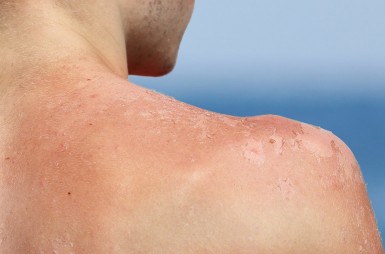Pregnancy mask:
all you need to know about the hyperpigmentation experienced by expectant mothers
Written by Paul Musset, Doctor in Pharmacy | published on | updated on 16/06/2022

Dreaded by many pregnant women, pregnancy mask – also known as melasma – affects 10 to 15% of expectant mothers. Although it is benign, the discomfort it can create on an aesthetic level is real. How does one get pregnancy mask? Is it possible to prevent it from appearing? And, once it is there, how to properly get rid of it?
Pregnancy mask explained
How to recognize melasma?
Pregnancy mask is characterized by the presence of pigmented plaques on the face. These large brown or grayish spots are generally mainly concentrated on the forehead, around the eyes, above the lips and on the cheeks. As symmetry on each side of the face is often observed, the term “mask” has been linked to that phenomenon. Melasma is totally benign. It is characterized by a lack of evenness in the complexion, yet it does not present any danger to your health.
The causes behind pregnancy mask
The precise origin of melasma remains unknown although we do know it is supposedly and mainly caused by a hormonal disorder. This is the reason why it mainly affects pregnant women, especially when hormone levels are at their highest (i.e. second part of pregnancy). Indeed, the excess of estrogens stimulates the production of melanin (i.e. the pigment which gives the skin its color) on a local level.
Simultaneously, family factors can have an effect and encourage the appearance of pregnancy mask. Genetic factors also play a key role in the predisposition to the development of melasma. Indeed, dark phototypes are naturally more sensitive to the development of this form of hyperpigmentation. This is why pregnancy masks are common on black skin.
The sun is the main activating factor of melasma
Melanin is a natural pigment whose role is to protect the skin against the harmful effects of the sun. When the skin is exposed to ultraviolet light, the melanocytes (i.e. the cells that can be found in the deep layers of the epidermis) are activated and bring up dark pigments which form a protective film.
Since the hyperpigmentation that results from pregnancy mask is linked to an overproduction of melanin, exposure to the sun naturally appears to be its main trigger.
Are pregnant women the only group of people affected by melasma?
They aren’t. Insofar as melasma is a hormonal problem, hormone-based treatments such as contraceptives (pill, implant, IUD, etc.) can also encourage the appearance of pregnancy mask.
How to avoid getting pregnancy mask?
The best ally against melasma: total block sunscreen
Melanin activates under the effect of ultraviolet rays. To limit its production and avoid having your face covered with brown plaques, it is essential to use a very high protection sunscreen (SPF 50 or 50 +), even in the winter. Indeed, it is worth noting that it sometimes takes only 5 minutes of unprotected exposure to get hyperpigmentation. In addition, frequent applications of total block sunscreen are essential to ensure sufficient protection.
Our best advice to avoid melasma
The best way to avoid the appearance of dark spots or to suffer from pigmentation disorders is primarily to take care of your skin on a daily basis following different stages:
- Clean your skin with soothing water such as a thermal water;
- Exfoliate it to remove impurities, dead skin and to help it benefit from the skincare products you’re about to apply;
- Hydrate it to reform the protective hydrolipid film of the epidermis.
Besides adopting this routine, there is not much we can advise. To avoid the appearance of unsightly plaques due to pregnancy mask, pregnant women should avoid prolonged exposure to the sun at the hottest time of the day. Indeed, even the best sunscreen cannot guarantee total protection over time.
In the event of unavoidable exposure, here are two tips to preserve your complexion:
- Apply a mineral powder with SPF over your sunscreen. This will strengthen the protection that is already provided by the sunscreen. The powder will also reinforce the protection applied as a first layer;
- Wear a wide brim hat, or a cap, that sufficiently covers your face.
Tobacco consumption enhances melasma
Did you know that… Tobacco and pregnancy are not really what you would call a great combination in terms of health and fetal development. You should also know that cigarettes are harmful to the skin. They have an oxidizing action on cells and alter skin elasticity: the latter dries out more easily and becomes more sensitive to the development of dark spots.
You already have pregnancy mask: how to get your even skin tone back?
Do note it is often inadvisable to treat melasma while you’re still pregnant. Indeed, the use of a depigmenting treatment can have harmful effects on the fetus, and, most of the time, the brown spots disappear on their own once the hormonal level returns to normal. It is essential to be patient as it can take a few months after childbirth for your skin to feel normal again, especially if breastfeeding. If pregnancy mask does persist beyond 6 months after childbirth or breastfeeding, you can resort to different solutions to remedy it.
Treatments using depigmenting active ingredients
You can use anti-stain creams with depigmenting active ingredients to get rid of pregnancy mask.
Among the active ingredients recognized for their effectiveness in reducing stains, you can find:
- Azelaic acid;
- Vitamin C;
- AHA Fruit acids;
- Kojic acid;
- Citric acid.
Peelings
In case of very pronounced pregnancy mask, the concentration of active ingredients found in creams is sometimes too low. In this case, you could resort to a peeling under supervision by a dermatologist.
Laser treatment
This other severe melasma treatment consists in eliminating the excess of melanin pigment by pigment, using photothermolysis.
Hormones often affect women at different levels. The skin is no exception and hormones playing around leads to mask of pregnancy. Fortunately, following some basic steps is enough to avoid it. If, in spite of everything, you suffer from hyperpigmentation, patience combined with a healthy beauty routine often remains the simplest and most effective weapon to remedy it.
Three key points to remember about pregnancy mask:
- The sun is the main factor leading women to suffer from pregnancy mask;
- Once melasma is there, it is essential to wait until the end of the pregnancy before acting on it; melasma usually disappear on its own within 6 months of childbirth;
- If pregnancy mask persists for more than 6 months after childbirth, there are several methods you can adopt to reduce it. At first, the application of a depigmenting cream may be sufficient. If this is not the case, a consultation with a dermatologist is recommended before considering another treatment (peeling, laser).



















